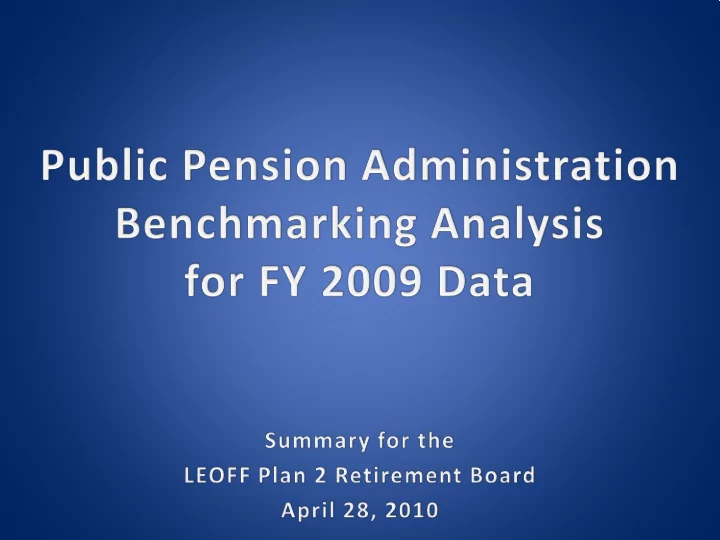

Someone actually benchmarks public pension administration … • Founded in 1992 • Started with investment management in Canada and the United States • The current service includes: – comprehensive benchmarking – a network for questions – a focused best practices analysis and – an international conference for participants
• Per CEM: “what gets measured gets managed” – Performance compared to real peers – An independent source of performance data – Ideas for improvement (some international) • A comprehensive approach – 40 page survey requiring 1,000 responses – Apples-to-apples data and cost comparisons – 300 page analytical report on results • DRS is compared to Peers/Group and All Participants • Incremental and rolled-up comparisons
• 73 systems participated in the FY 09 service – 36 US, 14 Canadian, 11 Australian, 10 Dutch, 2 Danish – DRS’ Peer Group is the 16 largest US systems (each having more than 250,000 Active Members and Annuitants) Michigan ORS Washington DRS NYSLRS Oregon PERS Illinois MRF Wisconsin DETF STRS Ohio Iowa PERS* Ohio PERS Cal PERS Virginia RS Cal STRS North Carolina RS Colorado PERA Indiana PERF* Arizona SRS Peer/participant from state Smaller participant from state *Iowa and Indiana replaced New Jersey and Maryland for FY 09 No participant from state
In general, DRS: • Is 3% larger than the peer group’s median for the number of Actives and Annuitants (A+A) • Is an “umbrella” administrator who also administers: a Hybrid DB/DC plan (i.e., the Plan 3’s) and • a 457 plan (i.e., the Deferred Compensation Program) but not • investment management • • Serves 20% more members per FTE than its peer median and • Receives data from 8% more employers than its peer median
CEM’s works to explain why costs differ. Economies of Scale (number of A+A) • DRS is 3% larger than the peer median Cost Environment (BLS data on state government wages) • Wages in Olympia are less than 1% above the peer median Transaction Volumes (a composite of 80 measures) • DRS scores 13% lower as more transactions are automated Plan Complexity (by cause and overall) • Service Level (by activity and overall) •
• Complexity Score – DRS’ score was 25% higher than the peer median – DRS has consistently had the 2 nd or 3 rd highest Complexity Score (of all participants) – DRS scores higher than the peer average in 12 of the 15 “causes” of complexity • Service Score – DRS’ score continues to hover around the peer median – DRS scores higher than the peer average in 8 of the 12 activity level measures – The other participants have caught up to DRS’ Service Score (closing a fairly small gap in 4 years) … but at what cost
CEM cautions participants that a higher Service Score “is not necessarily optimal or cost effective” • DRS could increase its Service Score by: +4.3 if we had single-activity-focused satisfaction surveys +2.6 if we increased content in member statements +1.6 if we increased online tools/transactions for members +1.2 if we performed 1-on-1 counseling at field locations • The data reflects our emphasis on being responsive to customers: Peer Peer Transaction DRS Median Average Days to provide a formal written pension estimate 4 6 13 Minutes to wait for 1-on-1 counseling without an appointment 2 10 11 Days to wait when scheduling 1-on-1 counseling 0 2 6 Seconds to reach an RSA* by phone 78 134 185 Days to provide a written service credit purchase cost estimate 2 10 19 *includes time spent navigating an auto-attendant, being routed by a receptionist and/or waiting on hold
• Total Cost per Member (Actives and Annuitants) – DRS’ cost is 28% below the peer median – DRS’ cost has consistently been low, while the cost of the other participants has increased over the past 4 years • Information Technology Cost and Capability – DRS spends 19% less per member on Information Technology (i.e., staff, equipment, mainframe processing, etc.), however, – DRS’ automated systems score at the peer median/average for their ability to provide services to members and employers • Benchmark (Predicted) Cost – DRS’ actual cost per member is 47% below its predicted cost – DRS’ actual cost has consistently been lower than what the data would predict
• Comprehensive benchmarking with our peers is a valuable source of data and ideas • It shows that DRS is a larger US administrator who: – Has a relatively Complex group of public pension systems – Provides solid Service (and is very responsive to customers) – Has cost-effective automated systems – Is low Cost, while the cost of others has gone up – Is lower than it’s Benchmark (“predicted”) Cost Any questions?
Recommend
More recommend